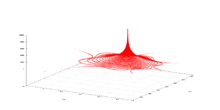- Orbit (dynamics)
-
In mathematics, in the study of dynamical systems, an orbit is a collection of points related by the evolution function of the dynamical system. The orbit is a subset of the phase space and the set of all orbits is a partition of the phase space, that is different orbits do not intersect in the phase space. Understanding the properties of orbits by using topological method is one of the objectives of the modern theory of dynamical systems.
For discrete-time dynamical systems the orbits are sequences, for real dynamical systems the orbits are curves and for holomorphic dynamical systems the orbits are Riemann surfaces.
Contents
Definition
 Diagram showing the periodic orbit of a mass-spring system in simple harmonic motion. (Here the velocity and position axes have been reversed from the standard convention in order to align the two diagrams)
Diagram showing the periodic orbit of a mass-spring system in simple harmonic motion. (Here the velocity and position axes have been reversed from the standard convention in order to align the two diagrams)
Given a dynamical system (T, M, Φ) with T a group, M a set and Φ the evolution function where
where 
we define
then the set
is called orbit through x. An orbit which consists of a single point is called constant orbit. A non-constant orbit is called closed or periodic if there exists a t in T so that
for every point x on the orbit.
Real dynamical system
Given a real dynamical system (R, M, Φ), I(x) is an open interval in the real numbers, that is
 . For any x in M
. For any x in Mis called positive semi-orbit through x and
is called negative semi-orbit through x.
Discrete time dynamical system
For discrete time dynamical system :
forward orbit of x is a set :
backward orbit of x is a set :
and orbit of x is a set :
where :
 is an evolution function
is an evolution function  which is here an iterated function,
which is here an iterated function,- set
 is dynamical space,
is dynamical space,  is number of iteration, which is natural number and
is number of iteration, which is natural number and 
 is initial state of system and
is initial state of system and 
Usually different notation is used : is noted as
is noted as 
 with
with  is a
is a  from above notation.
from above notation.
Notes
It is often the case that the evolution function can be understood to compose the elements of a group, in which case the group-theoretic orbits of the group action are the same thing as the dynamical orbits.
Examples
 Critical orbit of discrete dynamical system based on complex quadratic polynomial. It tends to weakly attracting fixed point with multiplier=0.99993612384259
Critical orbit of discrete dynamical system based on complex quadratic polynomial. It tends to weakly attracting fixed point with multiplier=0.99993612384259
- The orbit of an equilibrium point is a constant orbit
Stability of orbits
A basic classification of orbits is
- constant orbits or fixed points
- periodic orbits
- non-constant and non-periodic orbits
An orbit can fail to be closed in two ways. It could be an asymptotically periodic orbit if it converges to a periodic orbit. Such orbits are not closed because they never truly repeat, but they become arbitrarily close to a repeating orbit. An orbit can also be chaotic. These orbits come arbitrarily close to the initial point, but fail to ever converge to a periodic orbit. They exhibit sensitive dependence on initial conditions, meaning that small differences in the initial value will cause large differences in future points of the orbit.
There are other properties of orbits that allow for different classifications. An orbit can be hyperbolic if nearby points approach or diverge from the orbit exponentially fast.
See also
- Wandering set
- Phase space method
- Cobweb plot or Verhulst diagram
- Periodic points of complex quadratic mappings and multiplier of orbit
References
- Anatole Katok and Boris Hasselblatt (1996). Introduction to the modern theory of dynamical systems. Cambridge. ISBN 0-521-57557-5.
Categories:- Dynamical systems
- Group actions
Wikimedia Foundation. 2010.








